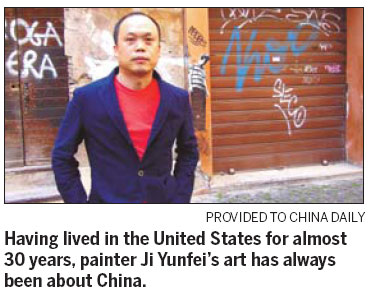Life and Leisure
Cultural inheritor
By Zhang Kun (China Daily)
Updated: 2010-08-11 12:31
 |
Large Medium Small |
Ji Yunfei had been painting the Three Gorges Dam for a few years before he actually visited the area. The artist, who has lived in New York since the mid 1980s, was surprised to see things were different from what he imagined.

In an early piece, Ji painted an enormous flood demolishing houses and crops. But after his visit, he realized that, "the water level would have to rise gradually, inch by inch".
He was deeply moved by the migrants, who were forced to give up their homes and fields.
"They were grocery shopping, cooking and living their lives just as usual. They seemed to take whatever happened with great patience and endurance," he says.
After his visit, Ji painted a long Chinese watercolor scroll, stretching 3.14 meters, depicting a panoramic scene of life near the Three Gorges before the villages were drowned by the rising water.
Ji had the painting made into woodprints and one of the 108 copies of the print is now on exhibition at the James Cohan Gallery in Shanghai, alongside a new series of paintings about Badong, a county in Hubei province near the Three Gorges.
Last week, he gave a lecture at the Shanghai Dutch Cultural Center, sharing with nearly 100 people in the audience his creative experience and understanding of art.
Born in 1963, Ji was accepted by the Central Art Academy when he was only 15.
"Like most art students, I believed oil paintings were superior to traditional Chinese art, so I studied at the No 2 oil painting studio headed by Dong Xiwen," he says.
Dong didn't teach him, but his art was familiar to Ji and his classmates. His masterpiece, The Founding Ceremony of the Republic, is displayed at the China Military Museum.
However, Ji soon grew bored with the systematic teaching of painting skills at the college, and he discovered an affinity for classical Chinese painting masters, such as Chen Laolian, who lived in the 16th century.
"That was real great art, and Chen Laolian was so modern!" Ji says, recalling his excitement at discovering the old master.
Ji was good at line drawing, and with his discovery of traditional Chinese art, he turned away from western oil painting to devote himself to Chinese ink painting.
In 1986, when he started his postgraduate study in the United States, he was disappointed to find only one Chinese name in a book on art history - Zao Wou-Ki.
"I believe Chinese culture has its own strengths that can compete against others. As a Chinese artist, I have a lot to do. There are tons of opportunities," Ji says.
He chose to paint contemporary issues using traditional ink techniques, and the sharp contrast between his subjects and painting style proved surprisingly refreshing.
Ji says it is the distance between his subject and its expression that makes his art interesting and meaningful.
Although he has lived in the United States for almost 30 years, his art has always been about China. His earlier series included such subjects as the Opium War in the 1840s, the Boxer Rebellion (1899-1901) and the People's Commune.
In the late 1990s, he started to work on the Three Gorges, reading widely about the dam project and its impact. He only got the opportunity to visit the area after the dam began construction in 2002.
"I took a minibus and went up the winding mountain road. The passengers were all smoking and watching a martial arts movie on the TV, but I looked out of the window and saw we were very close to the edge of the cliff," he says.
He went around the relocated villages in Yichang and chatted with the villagers.
"I can't help but think about China's modern history - we have been too eager to eliminate things, but human art and culture rely so much on inheritance," he says.
"Talking with the villagers greatly changed my understanding of the issue. I have lots of respect for their endurance. They are tough people, with superb survival ability.
"I was stunned, and decided it was good enough to just record what I saw. The facts alone have sufficient power."